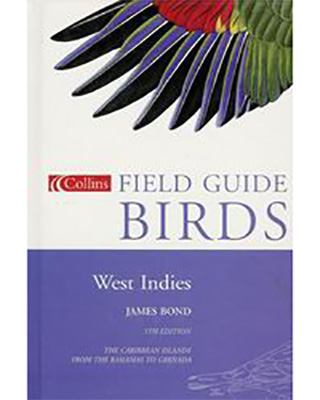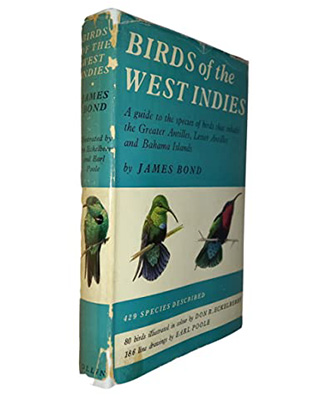Birds of the West Indies by James Bond

Birds of the West Indies is known not only for its exhaustive study of Caribbean birds but also because of the name of the book's author, the ornithologist James Bond, which was used by Ian Fleming for the name of his fictional British secret agent, Commander James Bond.
First published in 1936 (Philadelphia), the second edition (1947, MacMillan New York) was titled Field Guide To Birds Of The West Indies: A Guide To All The Species Of Birds Known From The Greater Antilles, Lesser Antilles and Bahama Islands. The book is still in print by the Peterson field guide company under the title, Birds of the West Indies.
From Grand Bahama Island in the north to Grenada in the south, this guide covers a tropical avifaunal region which includes such species as the tiny bee hummingbird, parrots, honey-creepers and todies. For every resident species, there are notes on diagnostic characters, local names, voices, habitat, identification and range.
Ian Fleming
Fleming, a keen bird watcher while living at his Goldeneye estate in Jamaica, knew the book. He later explained that he chose the name of its author for the hero of his first Bond novel Casino Royale in 1953, because he wanted a name that sounded 'as ordinary as possible'. Fleming wrote to the real Bond's wife, "It struck me that this brief, unromantic, Anglo-Saxon and yet very masculine name was just what I needed, and so a second James Bond was born."
 The version that Ian Fleming read in Jamaica might have been the 1936 or more likely the 1947 edition, as pictured here on the right. These First Editions can go for anywhere between $800 - $1000 on for example AbeBooks.com or on eBay.
The version that Ian Fleming read in Jamaica might have been the 1936 or more likely the 1947 edition, as pictured here on the right. These First Editions can go for anywhere between $800 - $1000 on for example AbeBooks.com or on eBay.
Die Another Day (2002) The book has become a collector's item amongst Bond fans and was featured as a homage in the twentieth James Bond film, Die Another Day when Bond poses as an ornithologist while in Cuba.
The book has become a collector's item amongst Bond fans and was featured as a homage in the twentieth James Bond film, Die Another Day when Bond poses as an ornithologist while in Cuba.
The book with the cover as seen in Die Another Day is hard to find. It's the Collins Field Guide Birds of the West Indies, 5th Edition. You can try to find it on eBay or on AbeBooks.com where some older versions are offered. If there is not a photo of the actual book for sale, make sure to ask the seller if the book indeed looks like the one you are looking for.
 SPECTRE (2015)
SPECTRE (2015)
The book also appears in a SPECTRE teaser image released on March 12th 2015. A SPECTRE clapperboard (with the date 10-03-2015) can be seen next to the 1960s first UK edition of the book on a table in a room in the London location where earlier scenes were filmed.
GoldenEye (1989 tv film)
The same 1960s UK edition of Birds of the West Indies as seen in the SPECTRE promotional photo can be spotted in the 1989 film GoldenEye, a biographical movie about Ian Fleming starring Charles Dance.
Get this 1960s UK first edition on eBay or on AbeBooks.
Complete the look
James Bond wears a Brioni floral shirt, Persol 2672 sunglasses, and holds a William Yeoward Double Old Fashioned tumbler.





















